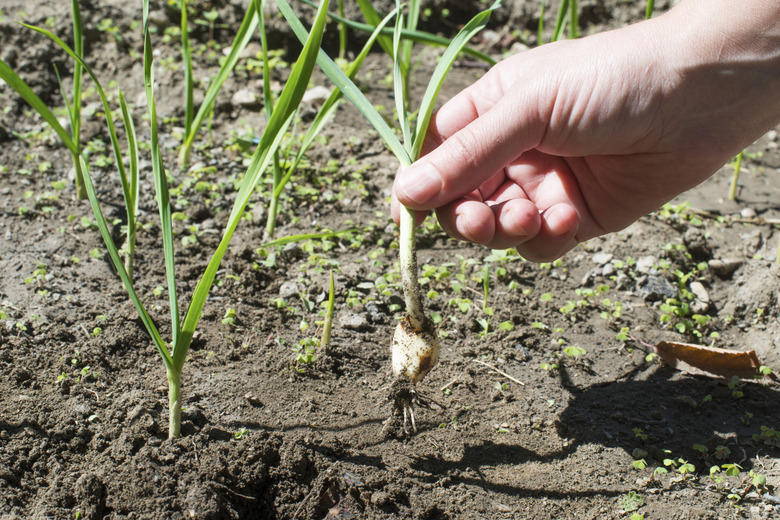How To Make Garlic Pesticide
Seen through the eyes of insects, the most peaceful garden in the world is a battleground for survival. All gardens attract plant-attacking insects, their predators and pollinators such as honeybees. When humans intervene with broad-spectrum chemical pesticides, bad and good insects alike pay with their lives. Before you launch an all-out attack on garden bugs, consider a less-toxic approach: homemade garlic pesticide.
How Garlic Pesticide Works
The U.S. Environmental Protective Agency classifies garlic as a "biochemical pesticide." In simple terms, this means garlic is a natural, nontoxic substance with no harmful environmental effects. Garlic simply repels insects with its pungent aroma. They avoid garlic-scented plants, going elsewhere to feed and lay their eggs.
Making Garlic Pesticide
Garlic's bug-repelling properties won't eliminate an existing insect infestation. To transform garlic repellent into a nontoxic but lethal treatment for soft-bodied insect pests, make your own garlic and soap solution.
Things Needed
- Measuring spoons
- Liquid castile soap
- Garlic powder
- Light cooking oil such as corn or canola
- Clean, 1-quart spray bottle never used for weedkiller
- Water
Step 1
Measure 1 generous tablespoon of the liquid soap, 1/2 tablespoon of the cooking oil and 1 teaspoon of garlic powder into the spray bottle. As a sticking agent, the oil helps the spray adhere to the plants.
Step 2
Fill the bottle with water, cap it and shake it thoroughly to blend the ingredients.
Step 3
Spray a few leaves on your target plants and wait 24 hours.
Step 4
Check the sprayed leaves for burned spots. If the plants are sensitive, dilute the spray by replacing one-half of it with plain water.
- Garlic's bug-repelling properties won't eliminate an existing insect infestation.
- Check the sprayed leaves for burned spots**.
- If the plants are sensitive, dilute the spray by replacing one-half of it with plain water.
Tip
- If your tap water is hard, use bottled water so soap scum doesn't form on the plants.
- This garlic pesticide only kills the insects it hits. For the best results, spray the plants until they drip and repeat after rainfall, or every two to three days, until the infestation subsides.
- Use the spray against aphids, scale insect larvae, spider mites, whiteflies, mealybugs, psyllids, Japanese beetles and boxelder bugs.
Warning
- Although the garlic in the spray should repel friendly insects while the soap suffocates the unfriendly ones, don't take chances. Protect honeybees by spraying early in the morning or after sundown, when they aren't active.
- Even though the ingredients are nontoxic, consider wearing safety goggles while spraying so the soap doesn't irritate your eyes.
- Spray plants when it's calm to prevent the spray from getting in your eyes or on your skin.
For more information on making organic pesticides, see "How to Make an Organic Pepper Spray for Plants," and "How to Make an Orange Oil Pesticide."
